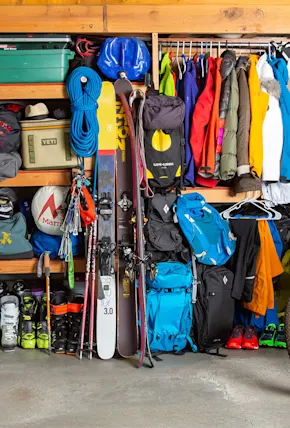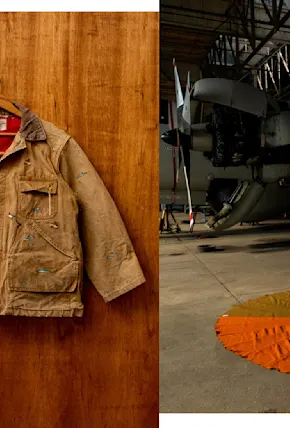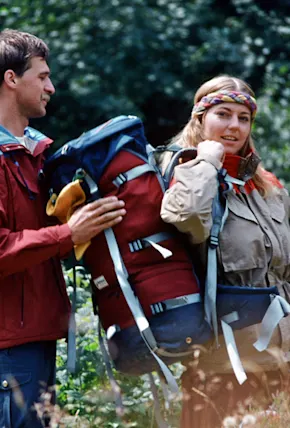Brand Specific Resell Channels
Brands read the trend reports too. In recent years no small number of major outdoor brands have launched their own in-house platforms for buying back and reselling used gear. The most robust is Patagonia Worn Wear, followed by Arc’teryx ReBird and The North Face Renewed.
For non-brand-specific finds, aggregators like Geartrade and Rerouted use a peer-to-peer model to offer gear. Ebay is an obvious resource, but bidding wars are never fun. Other online resale shops like Grailed, Etsy, and Goodwill online can be great resources too.
Instagram Vintage Shops for Outdoor Gear
On IG there's no shortage of quality accounts focused on outdoor gear, from action sport inspired accounts like Vintage Sponsor and Thrift Boards (the later appealing largely to niche Y2k era snowboard enthusiasts) to fly fishing-focused Vintage Trouts and Fish & Thrift. Here grails hit the grid daily.

Wilderness Exchange Consignment Shop in Denver, CO
IRL Gear Exchanges & Used Sporting Goods Stores
If you can, go for the IRL option. Whenever I travel to mountain towns, stateside or internationally, I always google search for used outdoor goods stores. In Bozeman, Montana I found a stash of $2 Chouinard Equipment carabiners. In Sapporo, Japan, shelves of perfectly patina-ed titanium Snow Peak cookware. I’ve found $10 Filson twill work shirts at a Goodwill in Homer, AK, and a Woolrich hunting jacket from an Austin fashion boutique for a clean $25 dollars that would easily fetch $250 on Ebay.
Gear Exchanges and used sporting goods stores are a staple of recreation hubs the world over. Prices may be higher than your run-of-the-mill thrift store, but so is the vetting process.
Cody Jackson, consignment manager at Denver, Colorado's Wilderness Exchange says the store's stringent review process “ensures that the pieces of clothing and gear are free of stains, tears, missing parts, damages,” making everything you buy functional and ready for use. Gear exchanges are good places to look beyond apparel and offer almost everything REI carries, but for a quarter of the price.
For fellow New Yorkers, keep an eye out for the annual Monroe Garden vintage outdoor popup at Pilgrim Surf + Supply.

Vintage Filson Sweater courtesy Chris Flynn of Vintage Trouts
Tips on How to Shop for Vintage Outdoor Gear
Knowing where to shop is part of the equation. Knowing how to shop? That’s the rest. So with the help of a few experts in the field, we’ve put together a cheat sheet for finding secondhand gear that works for you from the get-go.
Know Your Measurements
Sizing varies from brand to brand and decade to decade. And with so much of the secondhand market online, knowing your measurements is the virtual world equivalent of a fitting room.
Chris Flynn of Vintage Trouts notes that, “sizing has changed through the years, so always make sure to ask for measurements if they are not provided.”
A good reference point is finding something that fits you well. Take its measurements with a cloth tape measure, the kind an old-school Italian tailor would use, and keep them on hand as a reference point to score the perfect bouldering double knees on eBay.
Shop by Material & Activity
Synthetic materials are filled with forever chemicals, fill the ocean with microplastics, and have a short shelf life. Filtering by durable natural fibers is the best way to discover under-the-radar deals. Sean Hagerty, of Swan Shop Vintage, says that in his opinion, “garments made of natural materials like wool, cotton, or leather tend to age more gracefully than garments made of synthetic materials like nylon or polyester.”
That old saying, cotton kills? It might not be true. Contemporary companies like Amundsen Sports, Appalachian Gear Company, and Barebones build modern goods from classic materials inspired by heritage designs.
“Vintage” has become a price-hiking search term. Shopping specific materials like “Shetland Wool” or “Waxed Cotton” can circumvent the resale upcharge and connect you with the same goods with friendlier pricing.

Inside the Vintage Sponsor archive
Know Your Terminology
If you’re new to thrifting gear, you might not know your Goodyear Welt from your Blake Stitch— a cheaper construction method that doesn’t easily allow cobbler to resole the shoe. Learning some terminology can help distinguish a good deal from a bad one.
Don’t Be Afraid of a Missing Button
Cosmetic defects are part of the deal From resale shops to REI garage sales, the more damaged something is, the cheaper it sells for. Don't worry if you've never picked up a sewing needle, many gear repairs are easy to learn and there are resources to guide you. Corey Simpson, head of product communication at Patagonia, points to Worn Wear's videos and repair guides as a good starting point.
Patches, like NoSo’s heat-activated ones, provide easy repairs for down jackets and other delicate products, no needle necessary. Just do your best to avoid duct tape. It works in a pinch but can damage your apparel long term. Instead, use speciality tapes like Gearaid Tenacious Tape, which can fix a hole in a tent fly without consequences.
After the initial repair, the best way to extend the life of your gear is to take care of it. By doing so, you can ensure that your gear not only performs at its best but also ages beautifully over time.

Photo courtesy Outdoor Recreation Archive
Raise Your Brand IQ
Far from being a label snob, knowing your brands can be a shortcut to knowing quality versus moth-ridden. Every niche has its experts, vintage gear included. Following resources on social, like the Utah State lead Outdoor Recreation Archive helps you recognize now-defunct outdoor brands or old labels in secondhand spaces.
Final Thoughts: Keep the Story Going
Used gear is tangible, it has a patina and history that communicates the bumps and bruises of outdoor life. Resurrecting these pieces and putting them back in the field can be the most exciting part of buying vintage gear—it keeps a story going. That’s why, despite a stack of new drinking vessels that need testing, I continue to reach for my grandfather’s dented Stanley thermos.
Cody Jackson, at Wilderness Exchange, puts it like this, “While new stuff is fine too, oftentimes used clothing has a cool soul to them, you'll save money shopping this way, and it's better for the environment!” Hard to argue with an expert.













